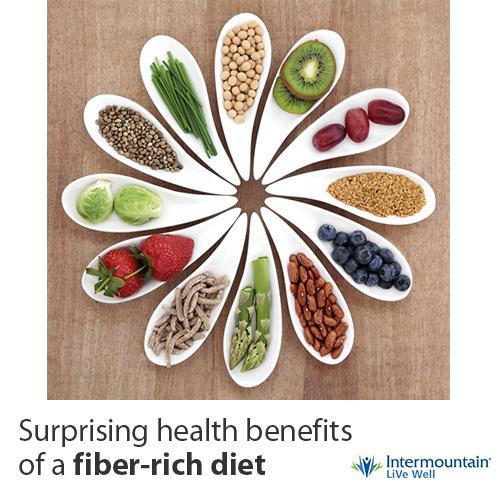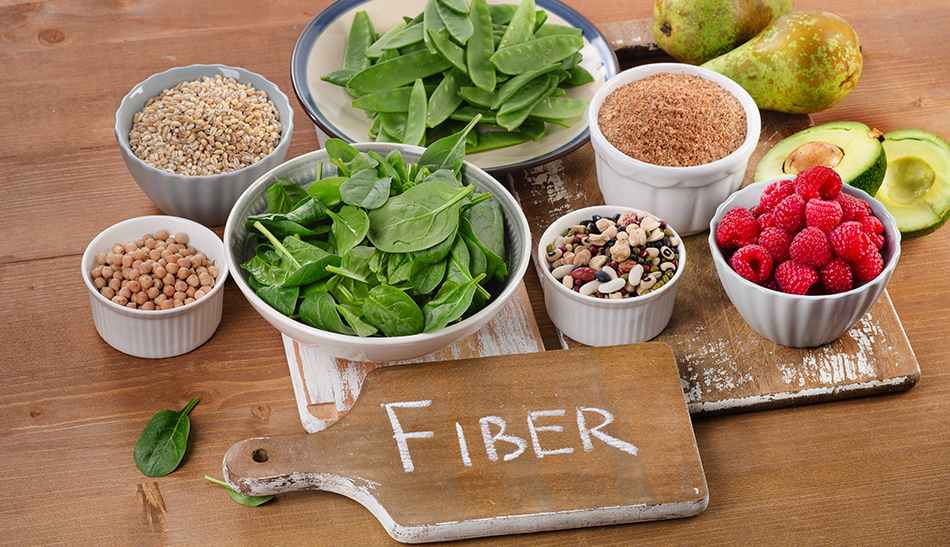Health Benefits of Fiber

Patients always ask if they should take more fiber to help with either their constipation or diarrhea, but few people know that consuming a high-fiber diet is important for everyone. Dietary fiber, or roughage, has been found to promote several health benefits in addition to bowel regularity. These include better control of cholesterol and blood sugar, lowering risk of diabetes or heart disease, aiding in weight loss and preventing obesity, and even reducing the risk of cancer.

Dietary fiber is found in all plant-based foods such as whole grains, fruits, vegetables, nuts, and legumes (beans, peas, and lentils). Although it is considered a carbohydrate, dietary fiber is different from other carbohydrates which are broken down into sugar molecules. Instead, dietary fiber is not digestible, meaning that it travels through the body without being broken down the way enzymes break down other food substances, such as proteins, sugars, fats, and other types of carbohydrates.
The term dietary fiber collectively includes both types of fiber found in plant-based food— Here is a closer look at each type, as well as how a diet high in dietary fiber can benefit our health.
Soluble Fiber
Soluble fiber is the type of dietary fiber that can dissolve in water. This type of fiber is found in many whole foods including oats, beans, nuts, peas, lentils, flaxseed, barley, as well as in the soft parts of fruits such as apples, blueberries, grapes, prunes, and citrus fruits. As soluble fiber passes through the digestive tract, soluble fiber absorbs water to become a gel-like substance which helps to slow down the digestion process. This makes soluble fiber helpful in relieving diarrhea by soaking up extra water, firming up the consistency of stool, and slowing down the speed that food travels through the digestive tract.
Soluble fiber also plays an important role in how our body digests sugars and starches.
The gel-like substance slows down how fast the stomach empties and also provides a barrier to prevent enzymes from penetrating and absorbing the starches found in food. Soluble fiber creates short-chain fatty acids which in turn, send signals to the liver to stop producing glucose. This reduces the amount of insulin required to stabilize blood sugars and can reduce glucose intolerance. In people who already have Type 1 or 2 Diabetes, consuming a diet high in soluble fiber can reduce the amount of insulin required to maintain a healthy blood sugar level.
Consuming soluble fiber (the kind that gels) on a regular basis can lower blood glucose and decrease the risk of developing Type 2 Diabetes.
In addition, soluble fiber promotes heart health through its role in lowering cholesterol. As soluble fiber travels through the digestive tract, it binds to bile acids and cholesterol which are then eliminated with the fiber. Over time, this leads to lowering LDL (low-density lipids, or “bad cholesterol”) from the blood, which can lower total cholesterol levels and reduce the risk of developing heart disease or strokes.
Insoluble Fiber
Insoluble fiber is the type of fiber that does not dissolve in water. As it passes through the digestive tract, insoluble fiber adds bulk, or weight, to the stool. Although it is not a laxative, insoluble fiber promotes optimal motility of the digestive tract, which can relieve constipation and encourages timely elimination of toxic wastes found in the colon. Insoluble fiber also softens the stool, easing the passage of bowel movements and decreasing the need for straining, which can help in both the prevention and treatment of hemorrhoids. It is found in wheat, rye, brown rice, legumes, and nuts as well as in the cells of plant walls. Green, leafy vegetables, as well as the skins and peels of most fruits and vegetables, are excellent sources of the insoluble fiber found in plant walls.
Dietary fiber also plays a role in both weight loss and preventing obesity. Since foods that are high in dietary fiber typically leave you feeling more satisfied and full, you may eat less, leading to weight loss over time. Many high-fiber foods are also low on the glycemic index, which is a scale that ranks how much a food will impact blood sugar levels. This results in fewer sugar spikes, which helps to prevent constant cravings and acts as a natural appetite suppressant. In addition, high-fiber foods are usually less “energy-dense,” meaning that they have fewer calories for the same volume of food when compared to low fiber foods.
High-fiber diets have also been studied for their role in preventing cancer. While researchers are still studying a possible connection to colon cancer, recent studies have found a link to breast cancer. Researchers have reported that a higher fiber intake among females during the teenage and young adult years is associated with a lower risk of developing breast cancer.
According to the Academy of Nutrition and Dietetics, the recommended daily intake of dietary fiber varies depending on age and gender – ranging from 21-38 grams per day. However, the USDA estimates that Americans are falling short of the guidelines and averaging only about 15 grams per day.
| Academy of Nutrition and Dietetics Recommended Daily Dietary Fiber Intake | ||
|---|---|---|
| Gender | Age – Under 50 Years | Age – Over 50 Years |
| Female | 25 grams per day | 21 grams per day |
| Male | 38 grams per day | 30 grams per day |
Although most plant-based foods contain both soluble and insoluble fiber, nutrition labels typically list the total amount of dietary fiber found in each serving vs. specifying the amount of fiber type. While both types of fiber play an important role in promoting optimal health, the focus should be on the total dietary fiber consumption meeting the daily recommended intake, with an effort to include as many sources of dietary fiber to the diet as possible.
How to Increase Your Dietary Fiber Intake
- Choose a breakfast cereal with whole grains listed as the first ingredient.
- Aim for at least five servings of fruits and vegetables per day – opting for fresh vs. canned, which have a lower fiber content.
- Replace white rice, bread, and pasta with whole grain products and brown rice.
- Add kidney, pinto or black beans to soups and salads.
- Choose snacks such as dried fruits and nuts, or granola bars with fiber added.
- Add wheat bran or oats to yogurt or smoothies and also when baking muffins, cakes, or cookies.
Increase Your Dietary Fiber Intake
Here are some tips for increasing dietary fiber:
- Choose a breakfast cereal with whole grains listed as the first ingredient.
- Aim for at least five servings of fruits and vegetables per day – opting for fresh vs. canned, which have a lower fiber content.
- Replace white rice, bread, and pasta with whole grain products and brown rice.
- Add kidney, pinto or black beans to soups and salads.
- Choose snacks such as dried fruits and nuts, or granola bars with fiber added.
- Add wheat bran or oats to yogurt or smoothies and also when baking muffins, cakes, or cookies.
Another way to increase dietary fiber is by taking a daily supplement. In fact, we often recommend fiber supplements as a way to help individuals manage various digestive conditions. However, keep in mind that supplements do not offer the same types of fibers, vitamins, minerals, and other important nutrients as a healthy diet consumed from a variety of whole foods rich in dietary fiber.
As you begin to add more dietary fiber to your diet, remember to drink plenty of water. Experts now recommend that individuals drink the equivalent of half their body weight in ounces of water each day. For example, this means that an individual weighing 150 lbs. should drink 75 ounces of water per day. Meeting the recommended water intake will help dietary fiber work best as it travels through the digestive tract. Also, keep in mind that it may be best to gradually increase daily fiber intake to prevent cramping, bloating or gas, which can be common when too much fiber is added too quickly.







